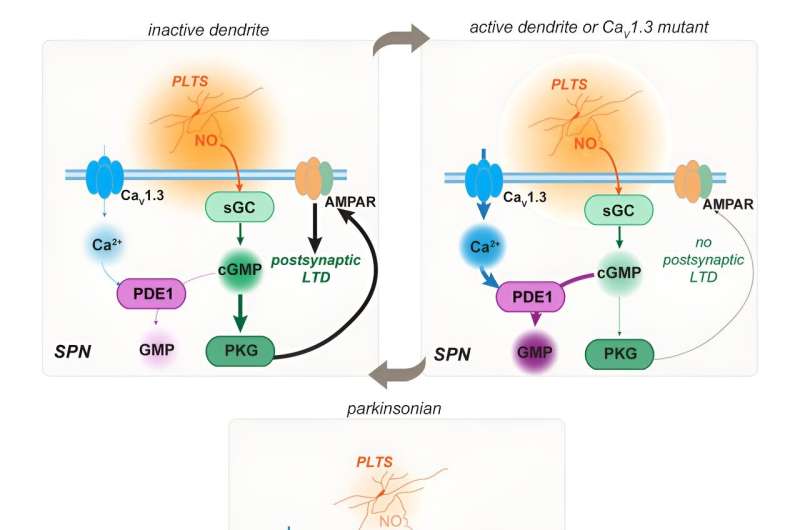
Northwestern Medicine investigators have uncovered a new way in which neurons in the brain “forget” associations that help guide behavior and habits, according to a study published in Cell Reports.
In addition to shedding light on basic brain mechanisms, the findings could also prove useful in treating Parkinson’s disease, said D. James Surmeier, Ph.D., the Nathan Smith Davis Professor and chair of Neuroscience, who was senior author of the study.
In the study, Surmeier and a team of Northwestern Medicine scientists set out to understand how spiny projection neurons—the principal neurons in the striatum, a key part of the brain circuitry controlling decision making—are affected by neuronal plasticity, which is critical to the brain’s ability to change and adapt over time in response to life experiences.
“Some years ago, we discovered a novel form of long-term synaptic depression in spiny projection neurons that was triggered by a gaseous messenger called nitric oxide,” Surmeier said. “The stratum is one of the few places in the brain that has very high levels of the signaling molecules that respond to nitric oxide. We wanted to get a better understanding of the role that form of plasticity played in controlling behavior.”
First, investigators studied an early step in the biochemical cascade triggered by nitric oxide—the metabolism of cyclic guanosine monophosphate (cGMP). They found that cGMP in spiny projection neurons was degraded by an enzyme (PDE1) that was turned on when neurons were active and letting calcium come into them.
They went on to find that the calcium activating PDE1 was coming through a specific type of membrane channel (Cav1.3 channel). This meant that the long-term depression of synapses triggered by nitric oxide was blocked in parts of the neuron that were actively processing information, in contrast to parts that were inactive.
This finding reveals how striatal spiny projection neurons operate on a “use it or lose it” basis, weakening synapses that were not actively involved in controlling behavior, Surmeier said.
“All of the commonly described forms of synaptic plasticity are dependent upon activity,” Surmeier said. “No one to our knowledge has described a form of synaptic plasticity that was enabled by inactivity at specific locations in a neuron.”
Next, investigators sought to understand this type of synaptic depression in the context of Parkinson’s disease.
In a mouse model of Parkinson’s disease, investigators observed that nitric oxide signaling and the synaptic depression it controlled was significantly diminished. However, by rebalancing levels of two neurotransmitters that are disrupted in Parkinson’s disease—dopamine and acetylcholine—investigators were able to restore nitric oxide signaling and this form of synaptic plasticity, according to the findings.
While more work is needed, the results suggest that nitric-oxide dependent synaptic depression could be a potential therapeutic target for Parkinson’s, Surmeier said.
“We found that the generation of nitric oxide was dependent upon reestablishing a balance between dopaminergic and cholinergic signaling,” Surmeier said. “Now, the question is how restoring nitric oxide signaling might fix what goes wrong in the striatum of Parkinson’s disease patients.”
Moving forward, Surmeier and his collaborators will continue to study the mechanisms of neuronal plasticity using cutting-edge techniques, he said.
“One of the things that we’re particularly excited about is that the tools we have to monitor and manipulate brain circuits has rapidly expanded, deepening our understanding of how Parkinson’s disease affects the brain and giving us strategies for reversing the changes in circuitry that cause symptoms,” he said.
“We are also excited about new tools to manipulate nitric oxide signaling being developed by the Silverman lab here at NU.”
More information:
Shenyu Zhai et al, Ca2+-dependent phosphodiesterase 1 regulates the plasticity of striatal spiny projection neuron glutamatergic synapses, Cell Reports (2024). DOI: 10.1016/j.celrep.2024.114540
Citation:
Scientists uncover new mechanism of ‘forgetting’ in brain neurons that could inform Parkinson’s treatment (2024, August 23)
retrieved 13 September 2024
from https://medicalxpress.com/news/2024-08-scientists-uncover-mechanism-brain-neurons.html
This document is subject to copyright. Apart from any fair dealing for the purpose of private study or research, no
part may be reproduced without the written permission. The content is provided for information purposes only.

